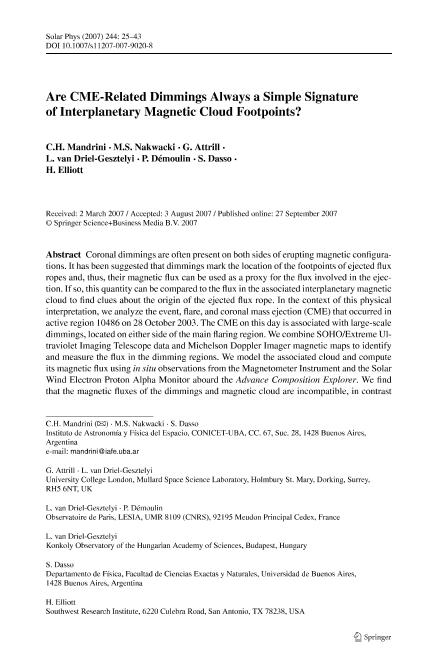Mostrar el registro sencillo del ítem
dc.contributor.author
Mandrini, Cristina Hemilse

dc.contributor.author
Nakwacki, Maria Soledad

dc.contributor.author
Attrill, G.
dc.contributor.author
van Driel Gesztelyi, Lidia

dc.contributor.author
Démoulin, Pascal

dc.contributor.author
Dasso, Sergio Ricardo

dc.contributor.author
Elliott, H.
dc.date.available
2017-08-07T19:18:29Z
dc.date.issued
2007-12
dc.identifier.citation
Mandrini, Cristina Hemilse; Nakwacki, Maria Soledad; Attrill, G.; van Driel Gesztelyi, Lidia; Démoulin, Pascal; et al.; Are CME-Related Dimmings Always a Simple Signature of Interplanetary Magnetic Cloud Footpoints?; Springer; Solar Physics; 244; 1-2; 12-2007; 25-43
dc.identifier.issn
0038-0938
dc.identifier.uri
http://hdl.handle.net/11336/21977
dc.description.abstract
Coronal dimmings are often present on both sides of erupting magnetic configurations. It has been suggested that dimmings mark the location of the footpoints of ejected flux ropes and, thus, their magnetic flux can be used as a proxy for the flux involved in the ejection. If so, this quantity can be compared to the flux in the associated interplanetary magnetic cloud to find clues about the origin of the ejected flux rope. In the context of this physical interpretation, we analyze the event, flare, and coronal mass ejection (CME) that occurred in active region 10486 on 28 October 2003. The CME on this day is associated with large-scale dimmings, located on either side of the main flaring region. We combine SOHO/Extreme Ultraviolet Imaging Telescope data and Michelson Doppler Imager magnetic maps to identify and measure the flux in the dimming regions. We model the associated cloud and compute its magnetic flux using in situ observations from the Magnetometer Instrument and the Solar Wind Electron Proton Alpha Monitor aboard the Advance Composition Explorer. We find that the magnetic fluxes of the dimmings and magnetic cloud are incompatible, in contrast to what has been found in previous studies. We conclude that, in certain cases, especially in large-scale events and eruptions that occur in regions that are not isolated from other flux concentrations, the interpretation of dimmings requires a deeper analysis of the global magnetic configuration, since at least a fraction of the dimmed regions is formed by reconnection between the erupting field and the surrounding magnetic structures.
dc.format
application/pdf
dc.language.iso
eng
dc.publisher
Springer

dc.rights
info:eu-repo/semantics/openAccess
dc.rights.uri
https://creativecommons.org/licenses/by-nc-sa/2.5/ar/
dc.subject
Coronal Mass Ejections: Low Coronal Signatures
dc.subject
Coronal Mass Ejections: Interplanetary
dc.subject
Magnetic Field: Photosphere
dc.subject
Magnetic Field: Interplanetary
dc.subject.classification
Astronomía

dc.subject.classification
Ciencias Físicas

dc.subject.classification
CIENCIAS NATURALES Y EXACTAS

dc.title
Are CME-Related Dimmings Always a Simple Signature of Interplanetary Magnetic Cloud Footpoints?
dc.type
info:eu-repo/semantics/article
dc.type
info:ar-repo/semantics/artículo
dc.type
info:eu-repo/semantics/publishedVersion
dc.date.updated
2017-08-04T15:44:10Z
dc.journal.volume
244
dc.journal.number
1-2
dc.journal.pagination
25-43
dc.journal.pais
Alemania

dc.journal.ciudad
Berlin
dc.description.fil
Fil: Mandrini, Cristina Hemilse. Consejo Nacional de Investigaciónes Científicas y Técnicas. Oficina de Coordinación Administrativa Ciudad Universitaria. Instituto de Astronomía y Física del Espacio. - Universidad de Buenos Aires. Facultad de Ciencias Exactas y Naturales. Instituto de Astronomía y Física del Espacio; Argentina
dc.description.fil
Fil: Nakwacki, Maria Soledad. Consejo Nacional de Investigaciónes Científicas y Técnicas. Oficina de Coordinación Administrativa Ciudad Universitaria. Instituto de Astronomía y Física del Espacio. - Universidad de Buenos Aires. Facultad de Ciencias Exactas y Naturales. Instituto de Astronomía y Física del Espacio; Argentina
dc.description.fil
Fil: Attrill, G.. University College London, Mullard Space Science Laboratory; Reino Unido
dc.description.fil
Fil: van Driel Gesztelyi, Lidia. Centre National de la Recherche Scientifique. Observatoire de Paris; Francia
dc.description.fil
Fil: Démoulin, Pascal. Centre National de la Recherche Scientifique. Observatoire de Paris; Francia
dc.description.fil
Fil: Dasso, Sergio Ricardo. Consejo Nacional de Investigaciónes Científicas y Técnicas. Oficina de Coordinación Administrativa Ciudad Universitaria. Instituto de Astronomía y Física del Espacio. - Universidad de Buenos Aires. Facultad de Ciencias Exactas y Naturales. Instituto de Astronomía y Física del Espacio; Argentina
dc.description.fil
Fil: Elliott, H.. Southwest Research Institute; Estados Unidos
dc.journal.title
Solar Physics

dc.relation.alternativeid
info:eu-repo/semantics/altIdentifier/doi/http://dx.doi.org/10.1007/s11207-007-9020-8
dc.relation.alternativeid
info:eu-repo/semantics/altIdentifier/url/https://link.springer.com/article/10.1007%2Fs11207-007-9020-8
Archivos asociados
